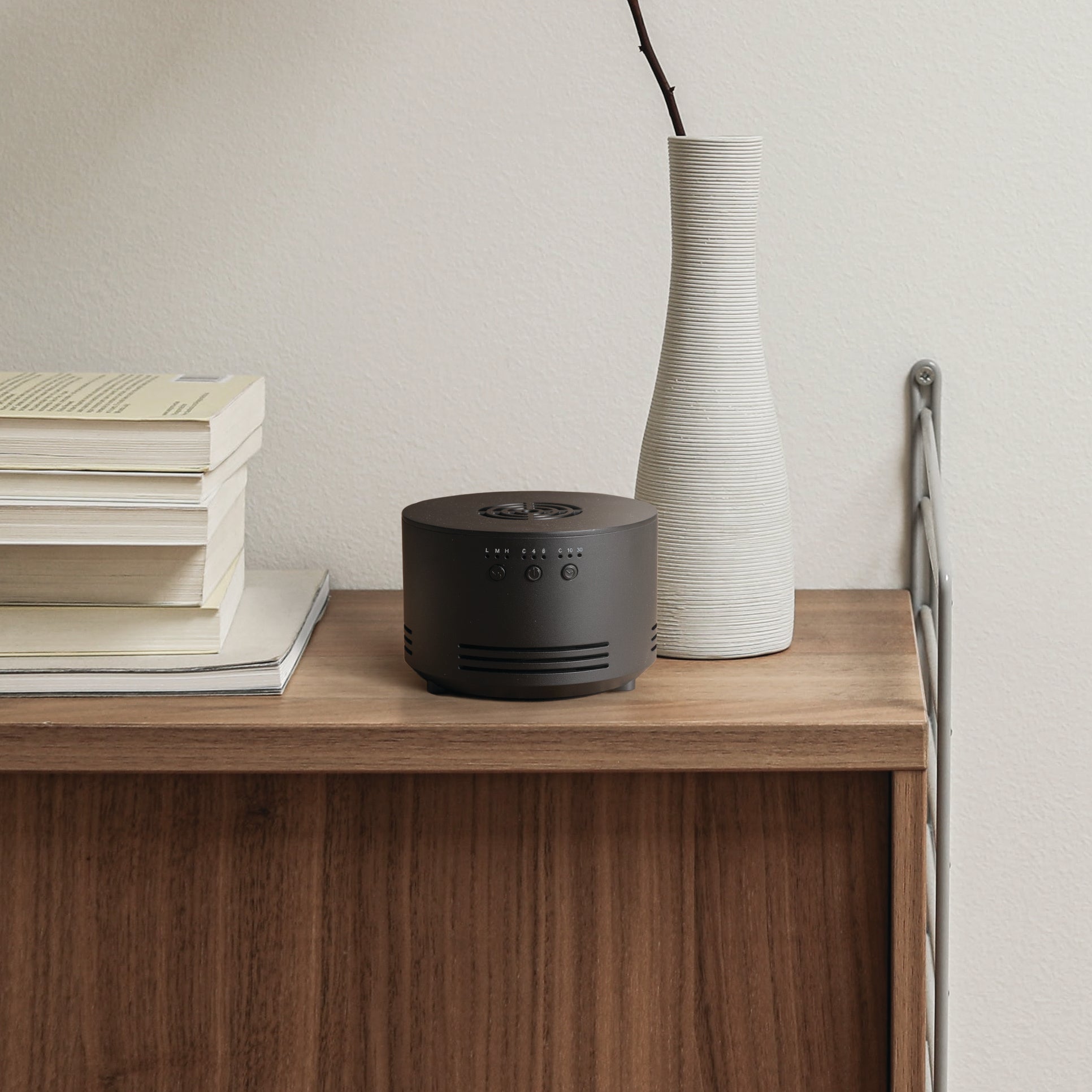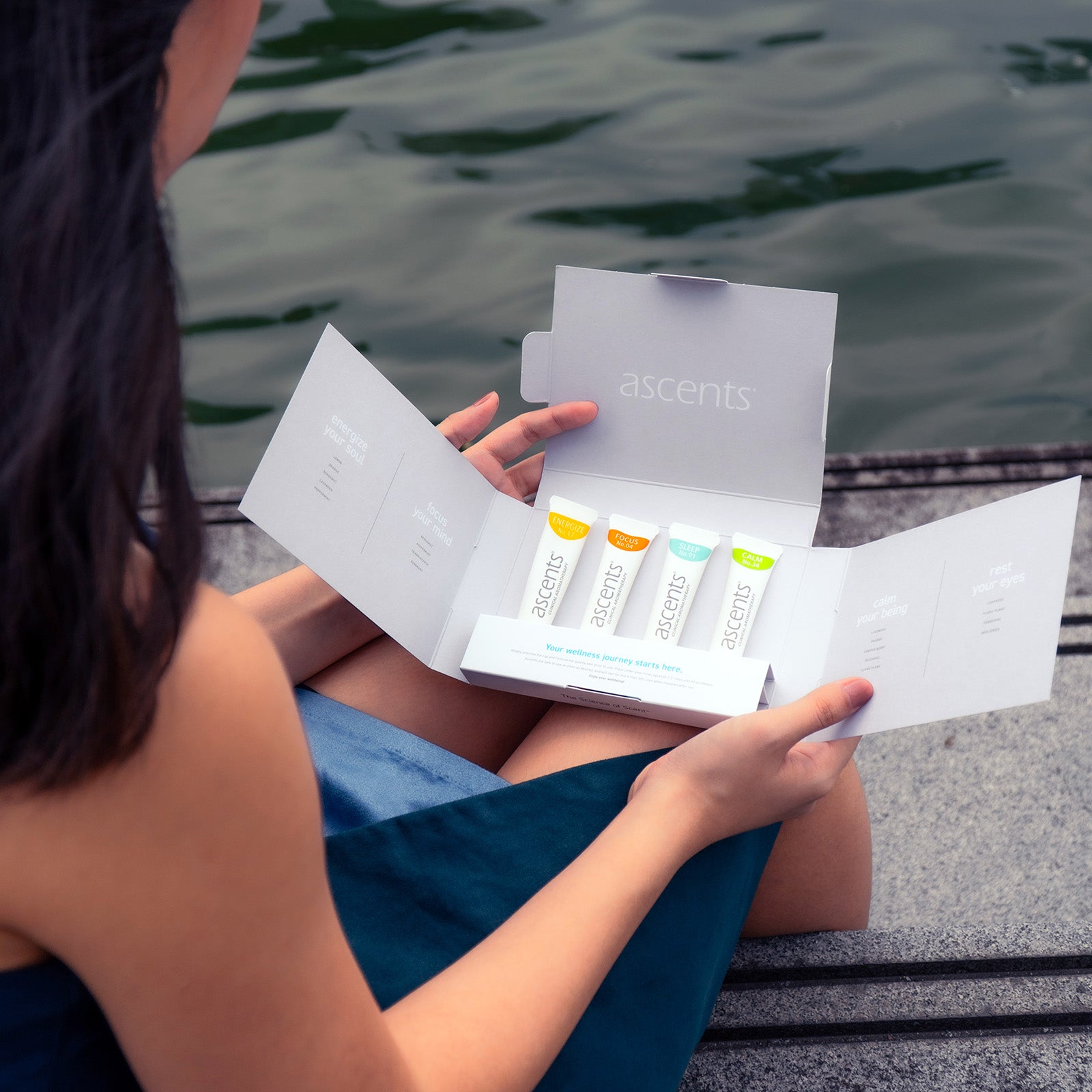Ascents® Nausea Relief No. 44: Research Abstracts for Component Oils
Effect of Ginger on Relieving Nausea and Vomiting in Pregnancy: A Randomized, Placebo-Controlled Trial.
Nurs Midwifery Stud. 2014 April; 3(1): e11841.
Published online 2014 April 17.
Farzaneh Saberi 1 ; Zohreh Sadat 2,*; Masoumeh Abedzadeh-Kalahroudi 2 ; Mahboobeh Taebi 3 1 Department of Midwifery, Kashan University of Medical Sciences, Kashan, IR Iran 2 Trauma Nursing Research Center, Kashan University of Medical Sciences, Kashan, IR Iran 3 Department of Midwifery, Isfahan University of Medical Sciences, Isfahan, IR Iran
*Corresponding author: Zohreh Sadat, Trauma Nursing Research Center, Kashan University of Medical Sciences, Kashan, IR Iran. Tel.: +98-9132768547, Fax: +98-3615556633, E-mail: sadat@kaums.ac.ir
Received: April 28, 2013; Revised: August 20, 2013; Accepted: November 27, 2013
Background: Nausea and vomiting are common and unpleasant complications in pregnancy. Although many alternative therapists support the use of ginger for nausea and vomiting of pregnancy, there is currently insufficient clinical evidence to support its use in this condition
Objectives: The present study was performed to assess the effectiveness of ginger in the treatment of nausea and vomiting in pregnancy.
Patients and Methods: This seven-day clinical trial was performed on 120 eligible pregnant women with symptoms of mild to moderate nausea and vomiting before 16 weeks gestation. They were divided into; ginger, placebo and control groups, by block randomization. Women were asked to record their nausea and vomiting for three days, and then participants received either ginger capsules, or a placebo for four days. No intervention was done with the control group. Data measure was self-recorded symptoms according to the Rhodes Index. Data were analyzed by ANOVA, ANCOVA, Kruskal-Wallis, Chi-square, and Fisher’s exact test, for the quantitative and qualitative variables.
Results: There were no statistical differences in the baseline demographics between the three groups apart from age of marriage and wanted or unwanted pregnancy. An ANCOVA test (covariance test) showed significant differences in mean scores after the intervention in the three groups (P < 0.001).
Conclusions: Ginger was effective for the relief of mild to moderate nausea and vomiting in pregnant women at less than 16 weeks gestation.
A Comparison of Aromatherapy to Standard Care for Relief of PONV and PDNV in Ambulatory Surgical Patients.
J Perianesth Nurs. 2018 Apr;33(2):116-128. doi: 10.1016/j.jopan.2016.09.001. Epub 2017 Mar 16.; Stallings-Welden LM, Doerner M, Ketchem EL, Benkert L, Alka S, Stallings JD.
CONCLUSIONS: Aromatherapy is an effective way to manage PONV/PDNV. Gender and age were the most important predictors of PONV.
Aromatherapy Versus Oral Ondansetron for Antiemetic Therapy Among Adult Emergency Department Patients: A Randomized Controlled Trial.
Ann Emerg Med. 2018 Feb 17. pii: S0196-0644(18)30029-5. doi: 10.1016/j.annemergmed.2018.01.016; April MD1, Oliver JJ2, Davis WT2, Ong D2, Simon EM2, Ng PC2, Hunter CJ2.
CONCLUSION: Among ED patients with acute nausea and not requiring immediate intravenous access, aromatherapy with or without oral ondansetron provides greater nausea relief than oral ondansetron alone.
Three statistical experimental designs for enhancing yield of active compoundsfrom herbal medicines and anti-motion sickness bioactivity.
Pharmacogn Mag. 2015 Jul-Sep;11(43):435-43. doi: 10.4103/0973-1296.160444.
Chen Y(1), Zhang C(2), Zhang M(3), Fu X(4).
Author information:
(1)Department of Molecular Cell Biology, Institute of Basic Medical Science, Chinese PLA General Hospital, Haidian District, Beijing 100853, China ; Department of Pharmacy, General Hospital of Beijing Military Region, Dongcheng District, Beijing 100700, China. (2)Department of Wound Repair and Tissue Regeneration, The First Affiliated Hospital (304th Hospital), General Hospital of PLA, Beijing 100048, PR China. (3)Department of Pharmacy, General Hospital of Beijing Military Region, Dongcheng District, Beijing 100700, China. (4)Department of Molecular Cell Biology, Institute of Basic Medical Science, Chinese PLA General Hospital, Haidian District, Beijing 100853, China ; Department of Wound Repair and Tissue Regeneration, The First Affiliated Hospital (304th Hospital), General Hospital of PLA, Beijing 100048, PR China.
BACKGROUND: Since antiquity, Zingiber officinale (ginger), pogostemonis herbal, and radix aucklandiae have been used as traditional Chinese medicines to remit gastrointestinal discomfort. Recent evidences also show the efficacy of the three herbal medicines against nausea and vomiting.
OBJECTIVE: To optimize the CO2 supercritical fluid extraction (SFE-CO2) conditions for ginger and the ethanol reflux extraction conditions for radix aucklandiae, control the quality of pogostemonis herba essential oil, and evaluate anti-motion sickness activity of the compound recipes composed of the three herbal medicine extracts.
MATERIALS AND METHODS: Two orthogonal array designs L9 (3)(4) were employed to optimize the SFE-CO2 conditions for enhancing yield of 6-gingerol from ginger and the ethanol reflux extraction conditions for enhancing yield of costunolide and dehydrocostus lactone from radix aucklandiae; a uniform design U5(5(3)) was applied for evaluation of anti-motion sickness activity of the compound recipes.
RESULTS: Extraction pressure (P < 0.01), extraction temperature and extraction time (P < 0.05) have significant effects on the yield of 6-gingerol from ginger by SFE-CO2; ethanol concentration (P < 0.01) and times of repeating extraction (P < 0.05) have significant effects on the total yield of costunolide and dehydrocostus lactone from radix aucklandiae by ethanol reflux extraction; the anti-motion sickness effects of the optimized compound recipe composed of the three herbal medicine extracts were markedly better than those of dimenhydrinate.
CONCLUSION: The compound recipe composed of ginger, pogostemonis herba, and radix aucklandiae could be developed as a promising anti-motion sickness medicine.
PMCID: PMC4522827
PMID: 26246716 [PubMed
Efficacy of ginger for nausea and vomiting: a systematic review of randomized clinical trials.
Br J Anaesth. 2000 Mar;84(3):367-71.
Ernst E(1), Pittler MH.
Author information:
(1)Department of Complementary Medicine, School of Postgraduate Medicine and Health Sciences, University of Exeter, UK.
Ginger (Zingiber officinale) is often advocated as beneficial for nausea and vomiting. Whether the herb is truly efficacious for this condition is, however, still a matter of debate. We have performed a systematic review of the evidence from randomized controlled trials for or against the efficacy of ginger for nausea and vomiting. Six studies met all inclusion criteria and were reviewed.
Three on postoperative nausea and vomiting were identified and two of these suggested that ginger was superior to placebo and equally effective as metoclopramide. The pooled absolute risk reduction for the incidence of postoperative nausea, however, indicated a non-significant difference between the ginger and placebo groups for ginger 1 g taken before operation (absolute risk reduction 0.052 (95% confidence interval -0.082 to 0.186)). One study was found for each of the following conditions: seasickness, morning sickness and chemotherapy-induced nausea. These studies collectively favoured ginger over placebo.
PMID: 10793599 [PubMed - indexed for MEDLINE]
Ginger Essence Effect on Nausea and Vomiting After Open and Laparoscopic Nephrectomies.
Nurs Midwifery Stud. 2015 Jun;4(2):e28625. doi: 10.17795/nmsjournal28625. Epub
2015 Jun 27.
Hosseini FS(1), Adib-Hajbaghery M(2).
Author information:
(1)Labbafinejad Hospital, Tehran University of Medical Sciences, Tehran, IR Iran.
(2)Trauma Nursing Research Center, Faculty of Nursing, Kashan University of Medical Sciences, Kashan, IR Iran.
BACKGROUND: Some studies reported that ginger was effective in prevention or treatment of post-surgical nausea and vomiting; however, there are controversies. In addition, no study compared the effects of ginger on nausea and vomiting after open and laparoscopic nephrectomies.
OBJECTIVES: The current study aimed to compare the effect of ginger essence on nausea and vomiting after open versus laparoscopic nephrectomies.
PATIENTS AND METHODS: A randomized, placebo trial was conducted on two groups of patients, 50 open and 50 laparoscopic nephrectomy. Half of the subjects in each group received ginger essence and the other half received placebo. Using a visual analogue scale the severity of nausea was assessed every 15 minutes for the first two post operative hours and the sixth hour. Frequency of vomiting was counted until the sixth hour. The placebo subgroups were treated similarly. Descriptive statistics were employed. Chi-square and Fisher's exact tests, paired and independent samples t-test and repeated measure analysis of variance were used to analyze the data.
RESULTS: Repeated measure analysis of variance showed that the type of surgery and the type of intervention as factors had significant effects on the nausea severity scores in the nine successive measurements (P < 0.001). In the first two post-operative hours, the mean vomiting episodes was 2.92 ± 0.70 in the subjects who underwent open surgery and received placebo while it was 0.16 ± 0.37 in patients with the same surgery but receiving ginger essence (P = 0.001). The mean vomiting episodes was 6.0 ± 1.33 in the subjects who underwent laparoscopic surgery and received placebo while it was 1.39 ± 0.78 in patients with the same surgery but receiving ginger essence (P = 0.001).
CONCLUSIONS: Using ginger essence was effective in reducing nausea and vomiting not only in the subjects who underwent open nephrectomy but also in the subjects of laparoscopic nephrectomy. Using ginger essence is suggested as a complementary remedy to prevent and treat post-operative nausea and vomiting in patients with nephrectomy.
PMCID: PMC4557412
PMID: 26339671 [PubMed]
Ginger-Mechanism of Action in Chemotherapy-induced Nausea and Vomiting: A Review.
Crit Rev Food Sci Nutr. 2015 Apr 7:0. [Epub ahead of print]
Marx W(1), Ried K, McCarthy AL, Vitetta L, Sali A, McKavanagh D, Isenring E.
Author information:
(1)a Centre of Dietetics Research, University of Queensland , St Lucia , QLD ,
Australia .
Despite advances in anti-emetic therapy, chemotherapy-induced nausea and vomiting (CINV) still poses a significant burden to patients undergoing chemotherapy. Nausea, in particular, is still highly prevalent in this population. Ginger has been traditionally used as a folk remedy for gastrointestinal complaints and has been suggested as a viable adjuvant treatment for nausea and vomiting in the cancer context. Substantial research has revealed ginger to possess properties that could exert multiple beneficial effects on chemotherapy patients who experience nausea and vomiting. Bioactive compounds within the rhizome of ginger, particularly the gingerol and shogaol class of compounds, interact with several pathways that are directly implicated in CINV in addition to pathways that could play secondary roles by exacerbating symptoms. These properties include 5-HT3, substance P and acetylcholine receptor antagonism; anti inflammatory properties; and modulation of cellular redox signalling, vasopressin release, gastrointestinal motility, and gastric emptying rate. This review outlines these proposed mechanisms by discussing the results of clinical, in vitro and animal studies both within the chemotherapy context and in other relevant fields.
The evidence presented in this review indicates that ginger possesses multiple properties that could be beneficial in reducing chemotherapy-induced nausea and vomiting.
PMID: 25848702 [PubMed - as supplied by publisher]
Recent developments in the prevention of chemotherapy-induced nausea and vomiting (CINV): a comprehensive review.
Ann Oncol. 2015 Jun;26(6):1081-90. doi: 10.1093/annonc/mdv138. Epub 2015 Mar 9.
Jordan K(1), Jahn F(2), Aapro M(3).
Author information:
(1)Department of Hematology and Oncology, Martin Luther University Halle-Wittenberg, Halle, Germany karin.jordan@uk-halle.de. (2)Department of Hematology and Oncology, Martin Luther University Halle-Wittenberg, Halle, Germany. (3)Clinique de Gentler, Multidisciplinary Oncology Institute, Gentler, Switzerland.
The prevention of chemotherapy-induced nausea and vomiting (CINV) has been revolutionized over the past 25 years. Guideline-based treatment means that vomiting can be prevented in the majority, but not in all patients. Therefore, antiemetic research continues with the goal of optimizing CINV control for all patients. This comprehensive review summarizes the research efforts in this field over the past few years. Emerging from this research are two new antiemetic agents, netupitant/palonosetron, the first antiemetic combination agent and rolapitant, a new NK1RA. In addition, studies have evaluated the benefits of olanzapine and ginger, explored optimal combinations of agents for delayed CINV prevention, confirmed that dexamethasone-sparing regimens are effective, and demonstrated the value of NK1RAs in high-dose chemotherapy settings as well as with certain moderately emetogenic chemotherapies such as carboplatin. Research has also validated the correlation between antiemetic guideline adherence and improved CINV control. Finally, regulatory authorities have utilized extreme caution in retiring some 5 HT3RAs or decreasing their maximum dose.
© The Author 2015. Published by Oxford University Press on behalf of the European
Society for Medical Oncology. All rights reserved. For permissions, please email:
journals.permissions@oup.com.
PMID: 25755107 [PubMed - in process]
Antiemetic activity of volatile oil from Mentha spicata and Mentha × piperita in
chemotherapy-induced nausea and vomiting.
Ecancermedicalscience. 2013;7:290. doi: 10.3332/ecancer.2013.290. Epub 2013 Jan 31.
Tayarani-Najaran Z(1), Talasaz-Firoozi E, Nasiri R, Jalali N, Hassanzadeh M.
Author information:
(1)Department of Pharmacodynamics and Toxicology, School of Pharmacy, Mashhad
University of Medical Sciences, Mashhad 91775-1365, Iran.
BACKGROUND: This study is aimed at determining the efficacy of Mentha spicata (M. spicata) and Mentha × piperita (M. × piperita) in preventing chemotherapy induced nausea and vomiting (CINV).
METHODS: This was a randomised, double-blind clinical trial study. Prior to the study, patients were randomly assigned into four groups to receive M. spicata or M. × piperita. Statistical analysis included the χ(2) test, relative risk, and Student's t-test. Fifty courses were analysed for each group that met our eligibility criteria. The treatment and placebo groups applied essential oils of M. spicata, M. × piperita, or a placebo, while the control group continued with their previous antiemetic regimen. Patients or guardians recorded the number of emetic events, the intensity of nausea over 20 h of chemotherapy, as well as any possible adverse effects that occurred during this time.
RESULTS: There was a significant reduction in the intensity and number of emetic events in the first 24 h with M. spicata and M. × piperita in both treatment groups (p < 0.05) when compared with the control and no adverse effects were reported. The cost of treatment was also reduced when essential oils were used.
CONCLUSION: M. spicata or M. × piperita essential oils are safe and effective for antiemetic treatment in patients, as well as being cost effective.
PMCID: PMC3562057
Comparison of fennel and mefenamic acid for the treatment of primary dysmenorrhea.
Int J Gynaecol Obstet. 2003 Feb;80(2):153-7.
Namavar Jahromi B(1), Tartifizadeh A, Khabnadideh S.
Author information:
(1)Department of Obstetrics and Gynecology, Shiraz University of Medical Sciences, Shiraz, Iran. namavarb@sums.ac.ir
OBJECTIVES: To compare the effect of Foeniculum vulgare variety dulce (Sweet Fennel) vs. mefenamic acid for the treatment of primary dysmenorrhea.
METHODS: A cohort of seventy women, 15-24 years old from a local university and high-school, who complained of dysmenorrhea were enrolled in this study. Ten cases were excluded due to evidence of secondary dysmenorrhea. The remaining 60 patients were graded mild, moderate and severe on the basis of a verbal multidimensional scoring system. Thirty patients with mild dysmenorrhea were also excluded from the study. Each of the 30 cases with moderate to severe dysmenorrhea was evaluated for three cycles. In the first cycle no medication was given (control cycle), in the second cycle the cases were treated by mefenamic acid (250 mg q6h orally) and in the third cycle, essence of Fennel's fruit with 2% concentration (25 drops q4h orally), was prescribed at the beginning of the cycle. These cycles were compared day by day for the effect, potency, time of initiation of action and also complications associated with each treatment modality, by using a self scoring system. Intensity of pain was reported by using a 10-point linear analog technique. Statistical analyses were performed by the independent sample t-test, paired t test and repeated measurement analysis method.
RESULTS: In the study group the mean age of menarche was 12.5+/-1.3 years, the mean duration of menstruation was 6.6+/-1.4 days with the mean cycle days of 27+/-3. The findings observed during menses were as follows: headache in 26.7%, nausea in 63.3%, vomiting in 23.3%, diarrhea in 33.3%, fatigue in 93.3% and leaving the daily tasks undone was reported in 86.9% of the cases. Both of the drugs effectively relieved menstrual pain as compared with the control cycles (P<0.001). The mean duration of initiation of action was 67.5+/-46.06 min for mefenamic acid and 75+/-48.9 min for fennel. The difference was not statistically significant (P=0.57). Mefenamic acid had a more potent effect than fennel on the second and third menstrual days (P<0.05), however, the difference on the other days was not significant. No complication was reported in mefenamic acid treated cycles, but five cases (16.6%) withdrew from the study due to fennel's odor and one case (3.11%) reported a mild increase in the amount of her menstrual flow.
CONCLUSIONS: The essence of fennel can be used as a safe and effective herbal drug for primary dysmenorrhea, however, it may have a lower potency than mefenamic acid in the dosages used for this study.
PMID: 12566188 [PubMed - indexed for MEDLINE]
Aromatherapy as treatment for postoperative nausea: a randomized trial.
Anesth Analg. 2013 Sep;117(3):597-604. doi: 10.1213/ANE.0b013e31824a0b1c. Epub
2012 Mar 5.
Hunt R(1), Dienemann J, Norton HJ, Hartley W, Hudgens A, Stern T, Divine G.
Author information:
(1)Carolinas Medical Center University, 8801 No Tryon, Charlotte NC 28262. rdhsac@aol.co.
BACKGROUND: Postoperative nausea (PON) is a common complication of anesthesia and surgery. Antiemetic medication for higher-risk patients may reduce but does not reliably prevent PON. We examined aromatherapy as a treatment for patients experiencing PON after ambulatory surgery. Our primary hypothesis was that in comparison with inhaling a placebo, PON will be reduced significantly by aromatherapy with (1) essential oil of ginger, (2) a blend of essential oils of ginger, spearmint, peppermint, and cardamom, or (3) isopropyl alcohol. Our secondary hypothesis was that the effectiveness of aromatherapy will depend upon the agent used.
METHODS: A randomized trial of aromatherapy with patients who reported nausea in the postanesthesia care unit was conducted at one ambulatory surgical center. Eligibility criteria were adult, able to give consent, and no history of coagulation problems or allergy to the aromatherapy agents. Before surgery, demographic and risk factors were collected. Patients with a nausea level of 1 to 3 on a verbal descriptive scale (0-3) received a gauze pad saturated with a randomly chosen aromatherapy agent and were told to inhale deeply 3 times; nausea (0-3) was then measured again in 5 minutes. Prophylactic and post nausea antiemetics were given as ordered by physicians or as requested by the patient.
RESULTS: A total of 1151 subjects were screened for inclusion; 303 subjects reporting nausea were enrolled (26.3%), and 301 meeting protocol were analyzed (26.2%). The change in nausea level was significant for the blend (P < 0.001) and ginger (P = 0.002) versus saline but not for alcohol (P < 0.76). The number of antiemetic medications requested after aromatherapy was also significantly reduced with ginger or blend aromatherapy versus saline (P = 0.002 and P < 0.001, respectively).
CONCLUSION: The hypothesis that aromatherapy would be effective as a treatment for PON was supported. On the basis of our results, future research further evaluating aromatherapy is warranted. Aromatherapy is promising as an inexpensive, noninvasive treatment for PON that can be administered and controlled by patients as needed.
PMID: 22392970 [PubMed - indexed for MEDLINE]





